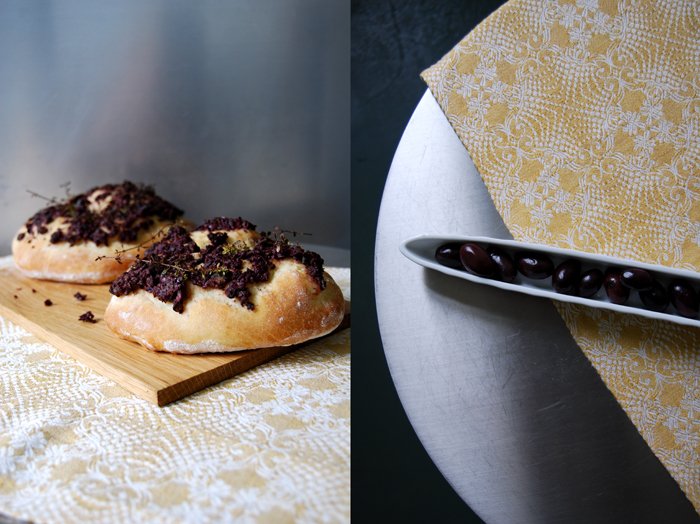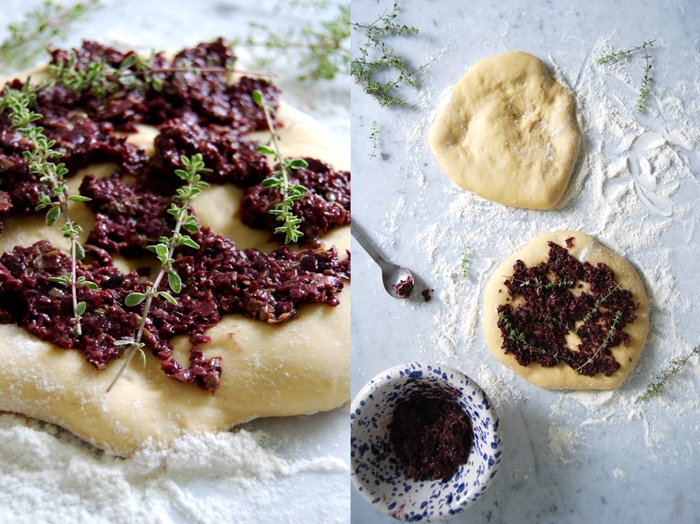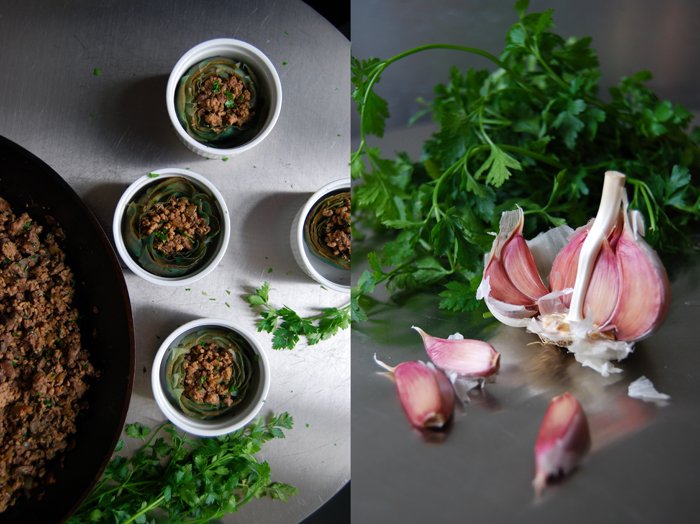Sicilian Sfincione with Tapenade
Forget thin and crisp, this pizza is thick and juicy! The Sicilian Sfincione is more like a focaccia, the dough is made with eggs and milk which gives it a bit of a sweet bread feeling. Its origin dates back to the late Baroque when the aristocratic Sicilian families liked to employ French chefs, the "Monzu" coming from the French Monsieur, some of them became famous Sicilian chefs. Here's the beauty of culinary exchange between two cultures, they influence each other, they don't confine each other but merge and evolve! If only cultural exchange was always so easy and well received!
In the beginning of the 18th century, these chefs started to influence Sicilian cuisine and left quite a few marks in the kitchen, also in the making of pizza. Eggs and milk, sometimes even butter, found their way into this famous dish and created completely different textures and tastes, like the popular Sfincione.
As there is already a French touch involved I thought I might as well continue working with it in the topping. I went for a rich Provençal tapenade made of lots of black olives, capers, anchovies, olive oil, brandy and lemon juice topped with thyme sprigs. It was great! This pizza is perfect for a picnic, as a starter or with a salad on the side. I love pizza, so much that I bake it every Sunday and this Sicilian variation is definitely a summer favourite!
Sfincione with Tapenade
For 4 Sfincione (15cm / 6") you need
For the dough
plain flour 500g / 1 pound
dry yeast 1 package (for 500g / 1 pound of flour)
salt 1/2 teaspoon
organic egg 1milk, lukewarm, 250ml / 8.5 ounces
Combine the flour with the yeast and salt, add the lukewarm milk and egg and mix with your dough hooks for a few minutes. Continue kneading and punching with your hands until you have an elastic dough ball and put it back in the bowl. Cover with a tea towel and let it rise in a 35°C / 95°F warm ( top / bottom heat, no fan!) oven for 45 minutes.
Divide the dough into 4, stretch into thick 15cm / 6" disks on a floured surface and cover with a kitchen towel. Let them rise while you continue the preparation for the tapenade.
For the tapenade
black olives 200g / 7 ounces
capers 40
anchovy, rinsed and dried, 2 fillets
olive oil 2 tablespoons plus more for sprinkling
brandy (or cognac) 2 tablespoons
freshly squeezed lemon juice 2 tablespoons
mustard 1 teaspoon
pepper
thyme 16 small sprigs for topping
Mix the ingredients for the tapenade in a blender and season with pepper to taste.
The Sfincione
Set the oven to 250°C / 480°F, my oven has a special pizza setting but you can use top / bottom heat as well. Line a baking sheet with parchment paper.
Spread a quarter of the tapenade on each pizza, put 4 thyme sprigs on top of each and bake for 6 minutes or until golden brown. Sprinkle with olive oil immediately and serve warm or cold.
Stuffed Maltese Artichokes with Meat and Brandy
In Maltese cuisine, stuffed vegetables have a long tradition. The island's soil and climate offer the right conditions for fruits and vegetables to grow and ripen under the Mediterranean sun with strong tastes and in huge quantities. Tomatoes, onions, marrows, zucchini, aubergines, pumpkins, all fruits and vegetables that are perfect to be filled! Be it with meat, seafood, herbs or other vegetables, you can combine flavours of all kinds or even use your leftovers to create a completely new dish you would have never thought of before. When I'm in an experimental mood, I bravely mix whatever I find in my fridge and shelves, sweet, sour, spicy or bitter, I've never been disappointed, but often surprised!
A few weeks ago I wrote about my stuffed zucchini, the filling was light and fluffy, made of ricotta, basil and lemon, perfect for the fruit's soft taste. When I decided to stuff some baby artichokes I had a stronger filling in mind, hearty, with minced pork and chicken liver which is an old, traditional Maltese recipe. To refine the meat's flavours I deglazed it with sweet brandy and infused it with an aromatic bay leaf and a pinch of cumin. I prepared everything in advance and warmed it up in the oven for a few minutes before dinner, in my little ramekins. The meal pretty and delicious!
Stuffed Artichokes with Minced Pork, Chicken Liver and Brandy
The artichokes can be prepared in advance and warmed up in the oven before serving.
For 6 stuffed baby artichokes you need
baby artichokes 6
minced pork 220g / 8oz
chicken liver, cleaned and finely chopped, 150g / 5 1/2oz
medium sized onion, finely chopped, 1
garlic, crushed, 2 cloves
brandy 40ml / 1 1/2fl oz
white wine 160ml / 5 1/2fl oz
bay leaf 1
cumin, ground, a pinch
parsley, chopped, the leaves of a small bunch
salt and black pepper
olive oil
juice of 1/2 lemon
Cut off the artichoke stems. If they are soft, peel and chop them finely and set aside. Pluck the hard outer leaves and cut the artichokes' tips off (1/3 – 1/2 of the artichoke), just the soft, fleshy part of the leaves should be left. Loosen the hairy choke with a knife and scoop it out with a spoon. Keep the prepared artichokes in a bowl of cold water and the juice of half a lemon once they are cut.
In a large pot, cook the artichokes in lots of salted water for about 10 minutes or until soft.
Set the oven to 200°C /390°F.
In a large heavy pan, heat a splash of olive oil and sauté the onion and garlic on medium for a few minutes until soft. If the artichoke stems are soft add them as well. Add a little more olive oil and fry the minced meat for 2-3 minutes. Add the liver, stir and fry for a minute. Add the bay leaf, parsley and cumin, deglaze with brandy and pour in the white wine, cook it down for 2 minutes. Season with salt and pepper and fill the artichokes with the minced meat mixture.
Place the artichokes in a big baking dish or 6 single ramekins, add a dash of white wine to cover the bottom of the dish and cook them in the oven for 5 minutes.










